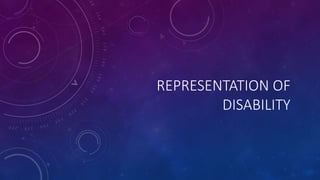
Representation of disability
- 2. TO START: WHAT IS YOUR RESPONSE TO THIS STATEMENT?:
- 3. LEARNING OBJECTIVES • To be able to understand depths of field and how focus can contribute to meaning • To be able to understand some of the ways disability is presented in TV Drama
- 5. HOW DOES DEPTH OF FIELD PLAY AN IMPORTANT PART IN THE REPRESENTATION OF DISABILITY? Example analysis – The technical code of an establishing shot of a barbed wire fence in shallow focus (See image above) connotes a potential enigma clue (Barthes) to the audience that the male character, who appears facially disfigured, is imprisoned, feels trapped and frustrated.
- 6. HOW DOES DEPTH OF FIELD PLAY AN IMPORTANT PART IN THE REPRESENTATION OF DISABILITY? Example analysis – The technical code of a multi shot provides a deep focus in order to equally accentuate the men in the shot where the disability is hidden. The message being that if disability is hidden then no discrimination will take place; they are equals. But what happens next shows that once disability is apparent prejudice creeps in
- 7. HOW DOES DEPTH OF FIELD PLAY AN IMPORTANT PART IN THE REPRESENTATION OF DISABILITY?
- 8. PHYSICAL ABILITY/DISABILITY • Who are we talking about? • Those who are physically disabled (paralysed, deaf, blind, amputees). • Those who are limited in how much they can do due to morbidly obese, cancer, aids, etc). • Those who are in good shape i.e. star athletes, superheroes, average person, one with special abilities.
- 9. QUESTIONS TO CONSIDER • Are there any disabled people represented within the show? Why or why not? • How are these people being represented? Are they victims? Does everyone have pity on them? Are they treated like everyone else? • What part do they have within the show, is it a crucial role? • What message are you getting about this specific disability or ability being represented in the clip? • Are the actors within the show actually disabled? If not why do you suppose they chose not to use an actor with a disability? - Is it right for actors to pretend to be something they are not?
- 10. IN A 1991 STUDY, PAUL HUNT IDENTIFIED 10 STEREOTYPES THE MEDIA USE TO PORTRAY DISABLED PEOPLE: • Can you think of any examples or COUNTERTYPES? • The disabled person as pitiable or pathetic • An object of curiosity or violence • Sinister or evil • The super cripple • As atmosphere • Laughable • His/her own worst enemy • As a burden • As Non-sexual • Being unable to participate in daily life
- 11. WHY DO THE MEDIA USE THESE STEREOTYPES? • Shakespeare (1999) presents a potential reason behind the use of one of these stereotypes: "The use of disability as character trait, plot device, or as atmosphere is a lazy short-cut. These representations are not accurate or fair reflections of the actual experience of disabled people. Such stereotypes reinforce negative attitudes towards disabled people, and ignorance about the nature of disability" In other words, the disability itself is often used as a hook by writers and film-makers to draw audiences into the story. These one-dimensional stereotypes are often distanced from the audience - where characters are only viewed through their impairment, and not valued as people. Shakespeare (1999) continues: "Above all, the dominant images [of disabled people] are crude, one-dimensional and simplistic."
- 12. DOMINANT NOTIONS OF DISABILITY: THE INDIVIDUAL MODEL • The societal view of disability generally conforms to the individual or overcoming or medical model of disability. This holds that disability is inherent in the individual, whose responsibility it is to ‘overcome’ her or his ‘tragic’ disability. Often this ‘overcoming’ is achieved through medical intervention, such as attempts at ‘cures’. For example, top wheelchair athlete Tanni Grey-Thompson was forced as a child to wear heavy leg callipers which gave her blisters, rather than being offered the simple and practical option of using a wheelchair. This approach to disability aims for the normalisation of disabled people, often through the medicalisation of their condition.
- 13. THE SOCIAL MODEL OF DISABILITY • This distinguishes between impairment (the physical or mental 'problem') and disability (the way society views it as being a negative). It holds that impairments are not inherently disabling, but that disability is caused by society which fails to provide for people with impairments, and which puts obstacles in their way. Examples include access: the built environment often does not allow access for people with mobility problems. Discriminatory attitudes are also disabling: for example, the idea that disability is a personal tragedy for the ‘sufferer’ impinges upon disabled people in a variety of negative ways, from their social relationships to their ability to get jobs. "Disability is produced in different forms, and in different proportions, in different cultures" (Oliver, 1996).
- 14. DIFFERENCE • It has been argued that dominant notions of ‘normality’ and beauty do not allow for the natural range of difference in human form. These notions are not only prejudicial to the acceptance of disabled people, but also increasingly impact on non-disabled people. • Charlotte Cooper, for example, applies the social model to obesity, and concludes that there are some important categories through which obesity can be defined as a disability: • A slender body is ‘normal’ • Fatness is a deviation from the norm. • Fat and disabled people share low social status. • Fatness is medicalised (e.g. jaw-wiring and stomach-stapling). • Fat people are blamed for their greed and lack of control over their bodies. Consider why it is that fat people or disabled people are rarely portrayed as sexually attractive.
- 15. DONNA IN ‘EASTENDERS’ How is disability represented through the character of Donna? • http://www.bbc.co.uk/iplayer/episode/b06j62yb/eastenders-15102015 • 02.58 the morning after • 05.50 in public • 12.05 with Nancy • 22.10 mate or date?
- 16. CASUALTY CLIP: HTTPS://WWW.YOUTUBE.COM/WATCH?V=NOIFQO5JQK8 • CAMERA WORK • EDITING • MISE EN SCENE • SOUND